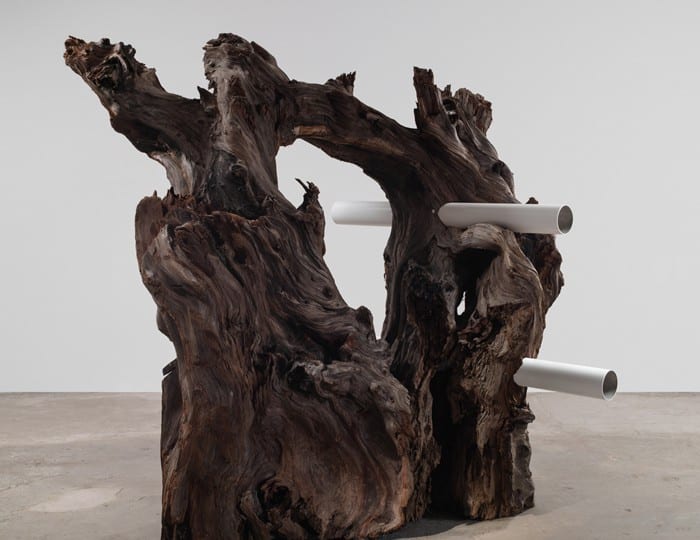In Carol Bove’s first exhibition at David Zwirner, London, The Plastic Unit, the subtle elegance emitted from the Mayfair townhouse, is sharply placed at odds with Bove’s curious combinations of materials. The exhibition’s offering of sleek minimalism, colliding with inevitabilities that exist in nature, is calculatingly laid out, with each room in the gallery, except for the third floor gallery space, containing four works. The combinations Bove presents juxtapose man-made industrial materials with those found in nature. The titles given to the works encourage and promote wider interpretations to be extracted while the formal structures maintain a pleasantly unique, slightly surreal minimalist voice.
The sole work on the third floor is Untitled (2014). It is comprised of four canvases that run across the majority of the wall and are visible as soon as the viewer enters. The canvases are decoratively layered in peacock feathers. Natural light streaming in from a window to the left of the work and the individual areas highlighted by soft spotlights, sees segments of rich greens and blues dance and twist accenting their colours and thus retaining, albeit in a new fashion, the feather’s primary function to attract. The impact of the sunlight throughout the day, as it manoeuvres across the canvases, weighs deeply on the work, steeping it in a poignant finality, which is highlighted by the works isolation from the rest of the works in the exhibition.
The durational aspects found in Bove’s work and the manner in which they are implicated through materiality, is a trope she frequently calls upon. On the ground floor is Lingam (2015), a large rusted I-beam that towers into the air. Vertically attached to that is a petrified piece of wood. This is perhaps Bove’s most becoming testimony to duration. The act of attaching the wood to the I-beam vertically – as if it the interjection of human production to keep it operating as nature intended – and its petrification, which fossilizes the wood, render the natural element within the work in an abstracted state that falls between living and not. However, its absence from either category, strongly evokes within the viewer, broader questions about their own mortality and the ability of modern medical practice can keep one alive.
On the second floor, a low plinth presents four works. Mussel Shell (2014) is comprised of a brass podium frame, with a layer of concrete on the top holding a steel mobile that dangles, a peacock feather and a seashell. In this, the industrial materials are delicately controlled in such a way that they elevate the peacock feather and seashell as a main focal point. However, they exist in a state of gripping harmony, defying the viewer’s preconceived notions of the physical qualities of industrial materials.
In contrast, in Self Talk (2015), Bove questions ideas surrounding materiality and the nature of public sculpture. The work is made up of four brightly coloured, irregularly shaped metal structures, displayed on a low plinth. Bove refers to them as “glyphs”. The vibrant tones and playful demeanour of the work reflects the qualities of public sculpture and so-called “plop art”, where the pieces’ narrative often colludes with its setting, thus making it appear out of place. A fete recognised by the title, Self Talk, which challenges the ability to approach art without preconceived notions. Thus giving the viewer the framework in which to readdress the very activity of producing sculptural practice.
Carol Bove: The Plastic Unit, until 30 May, David Zwirner, 24 Grafton Street, London, W1S 4EZ.
William Davie
Credits
1. Carol Bove, Circles, 2015 Redwood and steel 79 x 86 x 36 inches (200.7 x 218.4 x 91.4 cm) Courtesy David Zwirner, New York/London.





